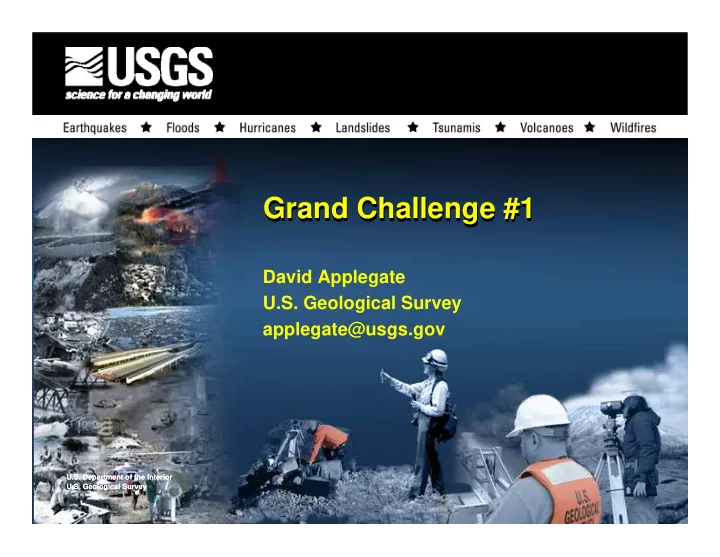

Grand Challenge #1 Grand Challenge #1 David Applegate U.S. Geological Survey applegate@usgs.gov U.S. Department of the Interior U.S. Department of the Interior U.S. Geological Survey U.S. Geological Survey
The Grand Challenges for Disaster Reduction (Published June 2005) 1. Provide hazard and disaster information where and when it is needed. 2. Understand the natural processes that produce hazards. 3. Develop hazard mitigation strategies and technologies. 4. Recognize and reduce vulnerability of interdependent critical infrastructure. 5. Assess disaster resilience using standard methods. 6. Promote risk-wise behavior. http://www.sdr.gov
Grand Challenge 1. Provide hazard and disaster information where and when it is needed. “To identify and anticipate the hazards that threaten communities, a mechanism for real-time data collection and interpretation must be readily available to and usable by scientists, emergency managers, first responders, citizens, and policy makers. Developing and improving observation tools is essential to provide pertinent, comprehensive, and timely information for planning and response.” “Warn the right people in the right place at the right time.”
Seismic is the start… The beach is the finish All Hazard Alert Broadcast system installed at Ocean Shores, Washington. Credit: W ashington Em ergency Managem ent
Improving situational awareness
ShakeMap supports targeted response and rapid loss estimation ShakeMap for the M6.0 Parkfield earthquake Sep. 28, 2004 Loss estimation results from FEMA’s HAZUS based on ShakeMap data
ShakeCast : Automatic Damage Assessment for Critical Facilities
ShakeMap now available to users as Google Earth transparent overlay Northridge ShakeMap in Google Earth (KML Format)
Situational awareness for humanitarian response
Greater specificity and lead time for warnings
Overview of Schools • Over 1,200 schools and campuses in region • Wide range of construction materials and age • Some level of upgrade completed but not well documented as a region www.eeri.org
Grand Challenge 1. Provide hazard and disaster information where and when it is needed. Challenges: • Improve data collection to increase understanding of the ways in which hazards evolve. • Create standards for sharing, storing and analyzing data.
National Volcano Early Warning Sytem: Closing the monitoring gap M O N IT O R IN G N V E W S T A R G E T S G A P K ila u e a , H I 1 E R U P T IO N S t. H e le n s , W A 1 E R U P T IO N R a in ie r, W A 3 H o o d , O R 3 S h a s ta , C A 3 S o u th S is te r, O R 3 L a s s e n , C A 3 M a u n a L o a , H I 2 R e d o u b t, A K 2 M a k u s h in . A K 2 G la c ie r P e a k , W A 4 A k u ta n , A K 2 B a k e r, W A 3 S p u rr, A K 2 N e w b e rry V o lc a n o ,O R 3 A u g u s tin e , A K 2 C ra te r L a k e , O R 4 In y o C ra te rs ., C A 3 A d a m s , W A , 2 V e n ia m in o f, A K 1 E R U P T IO N W ra n g e ll, A K 2 M o n o C ra te rs , C A 3 H u a la la i, H I 2 M e d ic in e L a k e , C A 3 P a g a n , C N M I 3 C h u rc h ill, A K 3 A n a ta h a n , C N M I 2 E R U P T IO N C le a r L a k e , C A 3 A la m a g a n , C N M I 3 K a g u y a k , A K 2 D u tto n , A K 2 H a y e s , A K 3 E m m o n s L a k e , A K 2 S e g u a m , A K 3 C h ig in a g a k , A K 3
Expansion of real-time in situ networks
A new generation of satellites and other remote-sensing capabilities
Recommend
More recommend